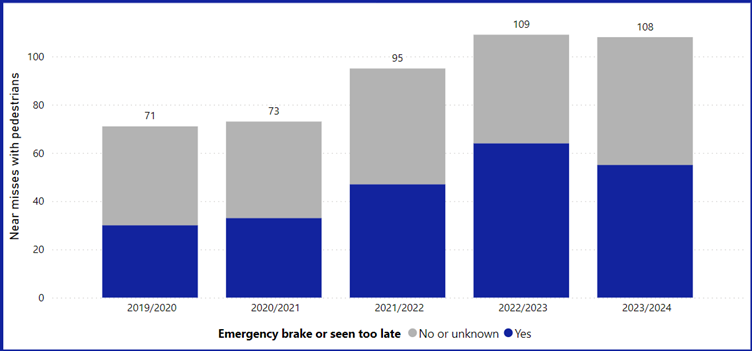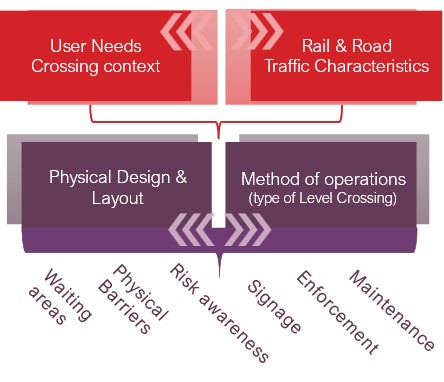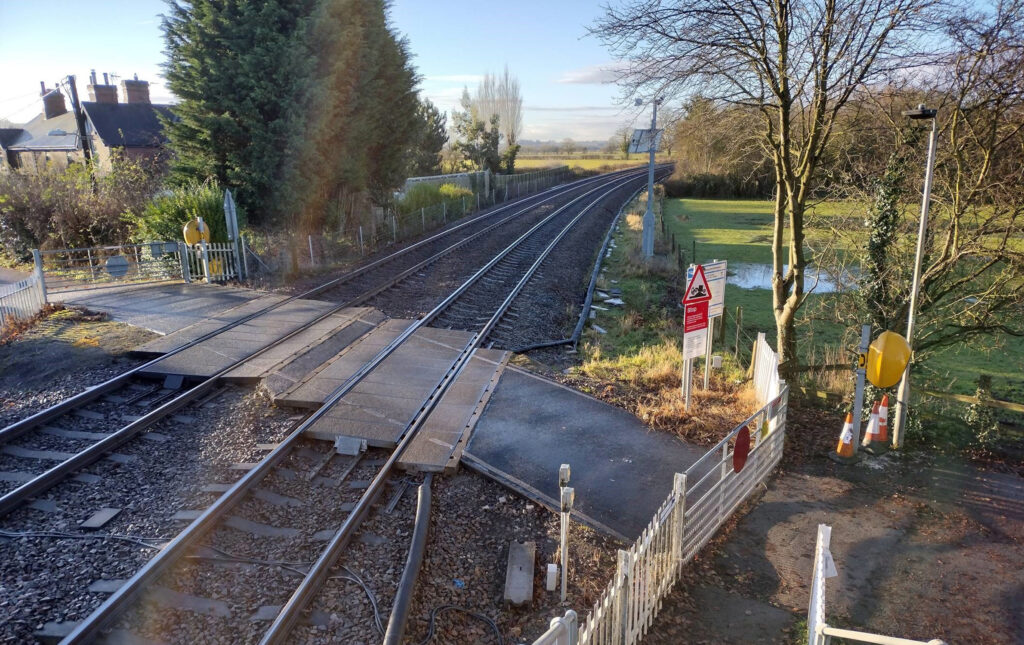Level crossings are intersections where rail and road traffic meet at the same level. Incidents at level crossings are potentially more likely to result in fatalities compared to road traffic incidents.
As high-risk intersections, level crossings are equipped with a broad range of safety warnings and measures. Notwithstanding the differences in the design of signage and other safety measures between countries, the exact combination of safety warnings for each level crossing will depend on the relative risk for that specific location.
Where level crossings are on busy roads with heavy vehicle or pedestrian traffic, they usually require some form of active warnings, such as lights and audible warnings. The type of protection does not only depend on the road traffic and layout, for example sighting distance and potential for bottlenecks, but also on rail traffic and infrastructure characteristics such as the number of tracks or frequency of rail services.
Passive level crossings are those where it is the road user’s responsibility to make a judgment about when it is safe to cross or rely on instructions from a signaller. For example, the user may have to ring a signaller for permission to cross.
Incidents post-Covid
Despite various measures aimed at reducing the risk at such intersections, the number of fatalities has remained high in recent years. When factoring in the much higher number of near misses with the potential to result in fatalities or significant infrastructure damage, this explains why safety at level crossings is an important issue – it represents 6% of the total mainline system risk.
The safest level crossing is a closed one, meaning it is no longer a designated place to cross the tracks. Despite a large number of crossings being closed in the last five years, the overall number of incidents has remained similar. This might imply that more incidents are now taking place per level crossing.
Near misses with pedestrians at passive and user-worked crossings – the largest proportion of level crossings on the UK network – are a particular issue. The Rail Safety and Standards Board’s (RSSB) database (figure 1 below), shows near-misses with pedestrians have substantially increased in the years following the national lockdowns introduced during the Covid-19 pandemic.

GB network (taken from RSSB Level Crossing data hub), 17/05/2024
The most obvious reason for such an increase is the ubiquitous shift of travel and work patterns. More people are now permanently or mainly working from home. There is a tendency to move away from busy cities to more rural and remote locations.
There is also a greater emphasis on and interest from the general public in mental and physical health and keeping active during work hours. All of these factors may have led to a significant change in the population using level crossings and more so for leisure purposes. This could certainly help explain the higher number of incidents, but there are other factors to be considered.
The shift in travel patterns and ever-growing population has introduced the need for multiple infrastructure upgrades and more frequent services across the network. Additionally, the last years have seen multiple service disruptions due to planned and unplanned maintenance works, staff shortages and strikes.
All these factors translate into a more dynamic and unpredictable operation of the railways today compared to a few years ago.
Behavioural patterns
In 2015, I completed my PhD thesis looking at the factors shaping pedestrians’ crossing decisions at level crossings. My findings shed light on psychological constructs such as the perception of control, the perception of safety, individual’s previous experience and social influences, to name a few. It is easy for regular users to stray into unsafe behaviours when they feel familiar with the crossing context – the direction and speed of timetabled trains, when they know a train is expected to stop at station before reaching the level crossing. However, there can always be a change in train timetables, there can always be a delayed fast train coming through instead of a stopping one.
Indeed, familiarity with a crossing is recognised as a major factor influencing decision-making. The Office of Rail and Road (ORR), in the most recent guidance for the management of risk at level crossings, emphasises the importance of including ‘human factors’ in design and risk assessments.
The guidance points to the need to understand people’s tendency to underestimate risk, especially when required to make quick decisions in familiar environments. It also stresses the need to communicate crossing instructions clearly and aim for seamless designs to reduce the potential for unintentional errors.
Understanding when people may be attracted to taking shortcuts or deviating from the rules and procedures around level crossings is one of the cornerstones of our profession as Human Factors specialists at SYSTRA.
Human Factors integration – Why we should strive to understand risks early on
When we talk about ‘Human Factors Integration’, we want to make sure that human capabilities and limitations are considered and integrated with all system aspects. It is therefore crucial we understand:
- Who the system users are?
- How demanding would the task be for people with different characteristics?
- What may distract them or influence their behaviour?
In addition to understanding behavioural patterns at level crossings, the other big theme of my PhD thesis was analysing the physical and socio-economic environment around level crossings. The context of use is not limited to the immediate infrastructure environment. It is about understanding the wider crossing context. What are the characteristics of the road/pavement leading to the crossing? What signage would be best suited and where is the best location for it? What local facilities or activities in the area may inform on user characteristics and journeys (such as schools, sport venues, shopping centres and so on)?
When upgrading existing level crossings or designing new ones, working with stakeholders to understand the user and the crossing context, along with the rail and road traffic characteristics, should dictate the appropriate layout and method of operation for the crossing (figure 2 below).

It also feeds into determining the specific upgrades and highlights the need to work closely with the community to raise risk awareness in the long term.
SYSTRA’s whole-system approach to level crossing safety management helps make crossings safer, tackles causes of user error and better deters intentional risk-taking.
Failure to take a system approach, underestimating the impact of any of these elements early in the design stages, may result in high unexpected costs in addition to safety risk. Expensive overbridges and even underpasses, for example, may be justified if the whole-life costs for level crossing upgrades, maintenance, control room upgrades, local area infrastructure upgrades, and safety and security staff costs are carefully considered.
SAFETY BY DESIGN VS AWARENESS
Designing safe level crossings is paramount, whether new infrastructure or upgrades to existing operations.
When it comes to design and engineering solutions, new technologies such as the obstacle detection capability and overlay miniature stop lights, have proven to be very effective and promising for the long-term safety targets. Network Rail is also considering various improvements to barriers to make them more conspicuous and reduce the risk of vehicles driving around.
These design and engineering solutions have to align with the crossing context and user needs at the specific location. With level crossings, there is not a one-size-fits-all design solution, which is why SYSTRA works closely with partners, clients and industry to ensure the fundamental safety principles are at the heart of the project.
Making a level crossing safer will always be a combination of design, engineering solutions, culture and enforcement.
Better education around the safe use of level crossings is always needed, especially given the changing railways characteristics and societal trends. Education needs to come from cross sector and across partnerships, as well as events such as the upcoming International Level Crossing Awareness Day.
It also comes from home and from the social world around us. It is everyone’s responsibility to act as a role model and educate where possible.
We should all help draw attention to the real risks for those who may not be aware. For instance, I found the recent Network Rail release on the story of Cristiano particularly impactful. It not only shows the consequences of such a traumatic event for the victim and their family, but also for rail staff and others involved.
Ultimately, it is our responsibility as engineers, human factors specialists and designers, to carefully consider the risks early on. Have we identified all foreseeable risks accounting for ‘human nature’ – human strengths and weaknesses – to deliver a design solution that is safe, and fit for each purpose?

- services
Level Crossings
Read more sur Level Crossings
- services
Technical Systems
Read more sur Technical Systems
- projects


 Australia
Australia  Brazil
Brazil  Canada
Canada  Chile
Chile  China
China  Columbia
Columbia  Denmark
Denmark  France
France  India
India  Indonesia
Indonesia  Ireland
Ireland  Italy
Italy  Malaysia
Malaysia  New Zealand
New Zealand  Norway
Norway  Panama
Panama  Peru
Peru  Poland
Poland  Portugal
Portugal  Saudi Arabia
Saudi Arabia  Singapore
Singapore  South Korea
South Korea  Spain
Spain  Sweden
Sweden  Taiwan
Taiwan  Thailand
Thailand  Türkiye
Türkiye  United States
United States  Vietnam
Vietnam